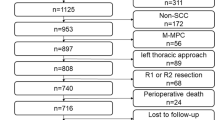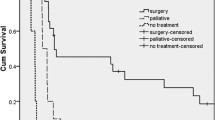Abstract
Purpose
Esophageal squamous cell carcinoma (ESCC) is occasionally observed with synchronous multiple tumor lesions. Our study is aiming to define the clinical and prognostic features of this pathological subtype.
Methods
This study included a large cohort of 1126 ESCC patients received esophagectomy with systemic lymph-node dissection between 2003 and 2013 in Sun Yat-sen University Cancer Center. The characteristics and prognostic significance of ESCC with multiple lesions were analyzed. The propensity score matching was performed to balance the baseline clinical characteristics.
Results
A total of 103 patients (9.1%) with 216 synchronous multiple lesions were identified from postoperative gross samples. Among them, 94 patients had two lesions, and 8 patients had three lesions, while only one patient had four lesions. The consistency of pT stages and histological grade among tumor lesions from the same gross sample were 19.4% (20/103) and 37.9% (39/103), respectively. Additionally, the tumor sites, sizes, and even the pathological subtypes can be variant in one patient. The preoperative upper gastrointestinal endoscopy could only identified 80.1% of the multiple tumor lesions. The male gender (P = 0.012), positive personal cancer history (P < 0.001), and higher pN stages (P < 0.001) were independent risk factors for synchronous multiple lesions. Patients with multiple lesions showed significantly lower survival rate (P = 0.002), and the multiple-lesion was an independently adverse prognostic factor in operable ESCC (P = 0.002).
Conclusion
ESCC with multiple lesions had unique clinical features and should not be simply treated as the one-lesion ESCC. Due to its worse prognostic impact, advanced multidisciplinary therapies should be considered for patients with multiple esophageal tumor lesions.


Similar content being viewed by others
References
Katada C, Muto M, Tanabe S, et al. Factors associated with the presence of multiple lugol-voiding lesions in patients with esophageal squamous-cell carcinoma. Dis Esophagus. 2014;27:457–62.
Muto M, Hironaka S, Nakane M, et al. Association of multiple lugol-voiding lesions with synchronous and metachronous esophageal squamous cell carcinoma in patients with head and neck cancer. Gastrointest Endosc. 2002;56:517–21.
Slaughter DP, Southwick HW, Smejkal W. Field cancerization in oral stratified squamous epithelium; clinical implications of multicentric origin. Cancer. 1953;6:963–8.
Druesne-Pecollo N, Keita Y, Touvier M, et al. Alcohol drinking and second primary cancer risk in patients with upper aerodigestive tract cancers: A systematic review and meta-analysis of observational studies. Cancer Epidemiol Biomarkers Prev. 2014;23:324–31.
Morita M, Saeki H, Mori M, et al. Risk factors for esophageal cancer and the multiple occurrence of carcinoma in the upper aerodigestive tract. Surgery. 2002;131:S1-6.
Baba Y, Yoshida N, Kinoshita K, et al. Clinical and prognostic features of patients with esophageal cancer and multiple primary cancers: A retrospective single-institution study. Ann Surg. 2018;267:478–83.
Katada C, Yokoyama T, Yano T, et al. Alcohol consumption and multiple dysplastic lesions increase risk of squamous cell carcinoma in the esophagus, head, and neck. Gastroenterology. 2016;151:860–9.
Team RC (2017) R: a language and environment for statistical computing
Austin PC. Balance diagnostics for comparing the distribution of baseline covariates between treatment groups in propensity-score matched samples. Stat Med. 2009;28:3083–107.
Li X, Lin S, Zhang Y, et al. Synchronous primary esophageal squamous cell carcinoma and gastric adenocarcinoma: Analysis of 41 cases treated in a single institution. Sci Rep. 2015;5:13335.
Souquet JC, Berger F, Bonvoisin S, et al. Esophageal squamous cell carcinoma associated with gastric adenocarcinoma. Cancer. 1989;63:786–90.
Koide N, Komatsu D, Hiraga R, et al. Esophageal cancer associated with other primary cancers–historical comparison of clinicopathologic features in 359 esophageal cancer patients. Hepatogastroenterology. 2010;57:513–8.
Muto M, Minashi K, Yano T, et al. Early detection of superficial squamous cell carcinoma in the head and neck region and esophagus by narrow band imaging: a multicenter randomized controlled trial. J Clin Oncol. 2010;28:1566–72.
Katada C, Tanabe S, Koizumi W, et al. Narrow band imaging for detecting superficial squamous cell carcinoma of the head and neck in patients with esophageal squamous cell carcinoma. Endoscopy. 2010;42:185–90.
He S, Liu Y, Liu X, et al. clinical characteristics of multiple primary cancer associated with esophageal squamous carcinoma. Zhonghua Yi Xue Za Zhi. 2015;95:2868–70.
Matsumoto M, Natsugoe S, Okumura H, et al. Clinicopathological and biological characteristics of esophageal squamous cell carcinoma associated with head and neck cancer. Oncology. 2004;67:98–102.
Muto M, Takahashi M, Ohtsu A, et al. Risk of multiple squamous cell carcinomas both in the esophagus and the head and neck region. Carcinogenesis. 2005;26:1008–12.
Hashibe M, McKay JD, Curado MP, et al. Multiple adh genes are associated with upper aerodigestive cancers. Nat Genet. 2008;40:707–9.
He W, Zheng C, Wang Y, et al. Prognosis of synchronous colorectal carcinoma compared to solitary colorectal carcinoma: a matched pair analysis. Eur J Gastroenterol Hepatol. 2019;31:1489–95.
Bugter O, van Iwaarden DLP, Dronkers EAC, et al. Survival of patients with head and neck cancer with metachronous multiple primary tumors is surprisingly favorable. Head Neck. 2019;41:1648–55.
Acknowledgements
Dr. JY Chen would like to thank her husband for the unconditional love and support, so that she is able to spend most of the after work hours on studies. Therefore, the birthday of her husband was chosen as the seed number of PSM to support the study.
Author information
Authors and Affiliations
Contributions
JYC designed the work. QWL retrospectively enrolled patients and interpreted the data. JHF approved the version to be published. JYC, SSZ, and XYF contributed to data analysis. JYC, JW, HY, and YJZ contributed to manuscript writing.
Corresponding authors
Ethics declarations
Ethical Statement
The study was approved by the IRB of Sun Yat-sen University Cancer Center and patient’s consent was waived.
Conflict of interest
No author reported any conflict of interest.
Additional information
Publisher's Note
Springer Nature remains neutral with regard to jurisdictional claims in published maps and institutional affiliations.
Supplementary Information
Below is the link to the electronic supplementary material.
Rights and permissions
About this article
Cite this article
Chen, JY., Zhang, SS., Fu, XY. et al. The characteristics and prognostic significance of esophageal squamous cell carcinoma with synchronous multiple lesions: over 10-year experience. Esophagus 18, 851–860 (2021). https://doi.org/10.1007/s10388-021-00856-8
Received:
Accepted:
Published:
Issue Date:
DOI: https://doi.org/10.1007/s10388-021-00856-8




